Note: If an image ever fails to appear - refresh your page, it really is there
Flags of Britain and the United Kingdom - Page 3
Historical Flags 1900 to Present Day
| Page #1 (c800-1800) | Page #2 (1800-1900) | Page #3 (1900-present) | English County Flags |
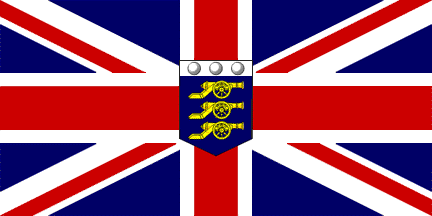
Army Council Ensign 1905-1945
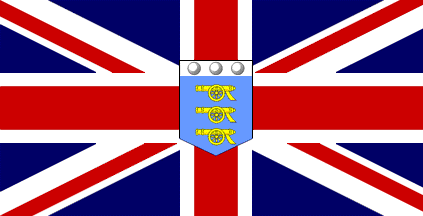
Army Council Ensign 1945-1964
|
Army Council Ensigns 1905-1964
The Army Council was committee of high ranking officers and civilian organizers headed by a Cabinet Minister who controlled the army, and had its own flag which was authorized in 1905.
The Army Council flag was a Union Jack with a shield bearing the arms of the old Board of Ordnance: three old-fashioned cannon arranged one above the other, gold on a blue field; above them are three old-fashioned cannon balls, side by side, white, but shaded so as to appear round, on a white field.
The Army Council was replaced by the Army Board, which uses a red over blue flag with the Royal Crest in the center.
Even though the Board of Ordnance shield (without the red border) was used in the center of a Union Jack as the flag of the Army Council and used at sea, it was not at first included in the Admiralty Flag Book. In 1919, however, the War Office asked that it be included in the next Flag Book and the Admiralty agreed to the request and it was added to the 1916 edition in 1920.
|
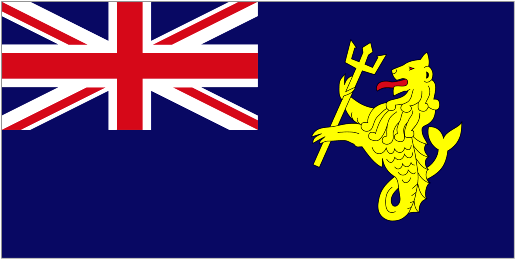
PLA Blue Ensign 1999
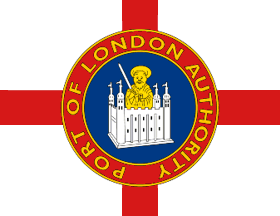
PLA House Flag
|
Port of London Authority Ensign/Flag 1908
The Port of London Authority (PLA) is a self-funding public trust established in 1908 by the Port of London Act. It is responsible for governing the Port of London, protecting the public right of navigation, and for conserving the Thames River and all its public docks between London and the sea.
Since 1911, the Port Authority Blue Ensign, with its "gold sea-lion grasping a trident" on the fly, has been used on all Port Authority patrol boats and ships. The version shown on the left came into use in 1999, replacing an earlier version (not shown) used between 1911-1999. The main difference between the versions was the size of the sea-lion emblem, which was considerably smaller on the older version.
The Port Authority House flag has the red Cross of St. George on a white field covered by the PLA arms within a yellow-edged red annulet inscribed with the words "Port of London Authority" in yellow lettering. The arms consist of a representation of St Paul, the patron saint of London, encamped up to his waist in the Tower of London, holding in his right hand a drawn sword and in his left hand a yellow scroll, all on a light blue background. |

RFC Ensign
|
Royal Flying Corps 1912-1918
The Royal Flying Corps, composed of a Naval Wing and a Military Wing, was constituted by Royal Warrant in 1912. However the Admiralty ignored this arrangement, and organized its own air service. The Naval Wing officially became the Royal Naval Air Service in 1914, which left the Military Wing to take the name Royal Flying Corps. In 1917 it was recommended that the Royal Flying Corps and the Royal Naval Air Service should combine to form a new air service, independent of either the Army or the Navy. This was effected on 1 April 1918 when the Royal Air Force was established. In 1937, the Fleet Air Arm was removed from the Royal Air Force and placed once again under the control of the Admiralty. The Fleet Air Arm being part of the Royal Navy used the traditional naval White Ensign.
The colours of the Royal Flying Corps ensign refer to the origins of the Service, dark blue from the Royal Navy, dark red from the Army, while light blue represents the Royal Air Force in the air. |
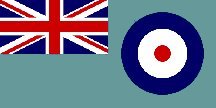
Royal Air Force Ensign
|
Royal Air Force Ensign since 1921
The Royal Air Force Ensign is the official flag of the Royal Air Force. The Ensign has a field of air force blue with the Union Flag in the canton and the Royal Air Force roundel in the middle of the fly.
The RAF Ensign was introduced in 1921, after some opposition from the Royal Navy. Currently it is flown from the flagstaff of every Royal Air Force station during daylight hours and permanently displayed as one of the flags flown on the famous Cenotaph that stands in Whitehall, London. The Cenotaph is a monument erected in honor of persons or groups whose remains are buried in foreign lands. Uniformed service personnel always salute the Cenotaph as they pass it. |
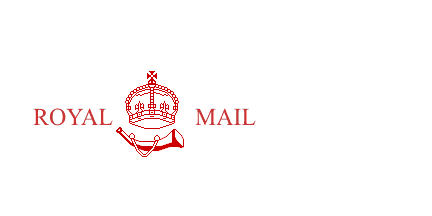
Royal Mail Service
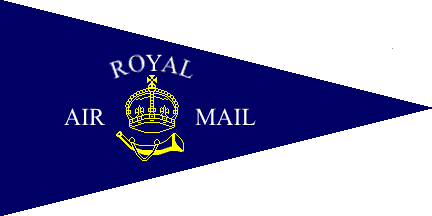
Royal Air Mail Service
|
Royal Mail Service c1930
The Royal Mail is the national postal service of the United Kingdom. Historically, the General Post Office was a government department which included the Royal Mail delivery business, represented in government by the Postmaster General, a Cabinet-level post. It became a limited corporation in 1969, eventually under the name of Consignia Plc, Consignia Holdings Plc, and finally Royal Mail Holdings Plc, which it is called today.
Royal Mail Holdings Plc, owns Royal Mail Group Limited, which in turn operates the brands Royal Mail (UK letters), Parcelforce Worldwide (UK parcels) and General Logistics Systems. Post Office Ltd, which provides counter services, is a wholly owned subsidiary.
During the 1930s the Royal Air Mail pennant was flown on land by mail-carrying aircraft and Air Mail facilities, alongside the Civil Air Ensign. Today, it is only used as a painted logo on the fuselages of Royal Mail carrier planes. |
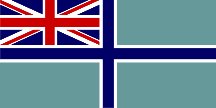
Civil Air Ensign
|
Civil Air Ensign since 1931
This little known member of the family of British-style ensigns was adopted in 1931
for use at United Kingdom airports and by aircraft registered in the United Kingdom.
The flag was originally adopted at the request of Imperial Airways, who felt that the
Red Ensign flown by their flying-boats at airports in the Mediterranean was unsuitable. This ensign was flown from Prime Minister Neville Chamberlain's plane while landed in Germany on his infamous visit to Munich and Hitler in 1938. |
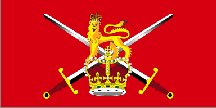
British Army Flag 1938
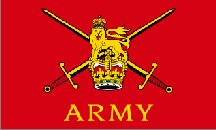
British Army Flag 1999
|
British Army Non-Ceremonial Flag
The British Army is the land armed forces branch of the British Armed Forces. It came into being with the unification of the Kingdoms of England and Scotland into the Kingdom of Great Britain in 1707. In contrast to the Royal Navy, Royal Marines and Royal Air Force, the British Army does not include Royal in its title. The British Army flag is mainly used in recruiting and military events and exhibitions.
The newest 1999 version of the Red British Army flag is controversial, and doesn't seem to be in much official use. The problem seems to be that it used the Army's logo version of the Royal Crest, complete with several heraldic mistakes (gold pearls on the crown, gold blades on the swords, the area under the arches filled in white rather than being transparent), and a really cuddly lion.
Actually, a new design for the Army Flag has been suggested to replace the Non-Ceremonial flag, hopefully to place them on equal footings with the other two Royal services. The flag would be have a royal crimson field with the Union flag in the canton and the Army badge of the Royal Crest on Crossed Swords filling the fly. Follow the link below to see a picture of it.
( Click here to find out why the British Army doesn't have "Royal" in it's title ) |
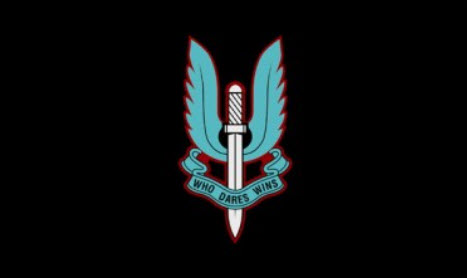
SAS Flag
|
Special Air Service 1941
The Special Air Service or SAS is a regiment of the British Army that has its origins back in 1941 and the Second World War. Today it is part of the United Kingdom Special Forces (UKSF), formed in 1987, along with the Special Boat Service (SBS), Special Reconnaissance Regiment (SRR), Special Forces Support Group (SFSG), 18th (UKSF) Signal Regiment, and the Joint Special Forces Aviation Wing. They form the Special forces, or special operations forces, which military units highly trained to perform unconventional, high-risk missions. The United Kingdom Special Forces have served as a model for the special forces of many other countries.
The SAS gained worldwide fame and recognition after successfully assaulting the Iranian Embassy in London and rescuing hostages during the 1980 Iranian Embassy siege, lifting the regiment from obscurity outside the military establishment. |
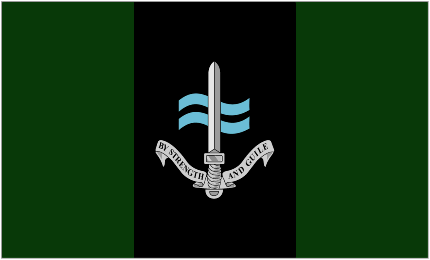
SBS Flag
|
Special Boat Service 1946
The Special Boat Service (SBS) is the special forces unit of the British Royal Navy, similar to the U.S. Navy Seals. The SBS is not an independent unit, but part of the Royal Marines. In the past to be eligible for SBS selection, a candidate usually would have served for at least two years in the Royal Marines or the Royal Navy, and then passed a rigorous selection course. However, today the SBS is open to non-marine members of other regiments and services from throughout the UK military. Together with the Special Air Service, Special Reconnaissance Regiment and the Special Forces Support Group, they form the United Kingdom Special Forces and come under joint control of the Director of Special Forces. The SBS can trace their origins to the Second World War when they were formed as the Special Boat Section in the 1940s.
|
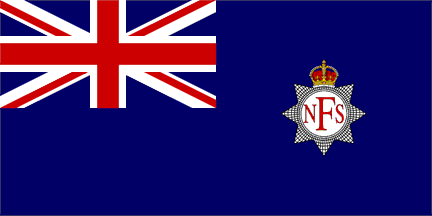
NFS "'Fire-boat" Ensign
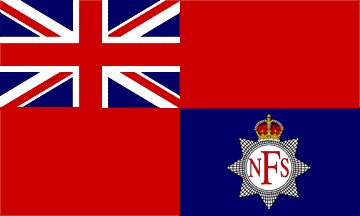
NFS "Land" Ensign
|
National Fire Service Ensign 1942-1948
The National Fire Service (NFS) was the single fire service created in Great Britain in 1941 during World War II in order to deal more effectively with the fires started by air raids. At peak strength the NFS had 370,000 personnel, including 80,000 women who were mostly employed on administrative duties. The NFS was divided into about forty Fire Forces. These were subdivided into Divisions. Each Division had two Columns and each Column had five Companies. It existed until 1948, when the fire services reverted back to local authority control.
The Red Ensign was approved in 1942 for land based units. A Blue Ensign with the NFS badge in the fly was approved by King George VI in 1943 for fire-boat stations and fire-boats. It is interesting to note that the NFS flag did not meet with everyone's approval. The Fire Brigades Union protested that the flag was a waste of time and material, and that the formal hoisting of the flag before morning roll-call was an unwanted charade that the firefighters didn't appreciate. Most of the protest seemed to exist because of the rather formal military-like ceremonies expected relating to raising the flags in the mornings and taking them down at night. |
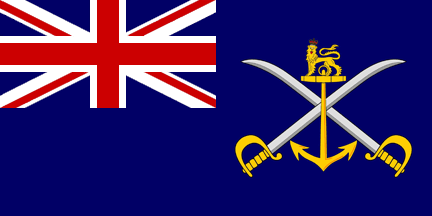
ASA Blue Ensign
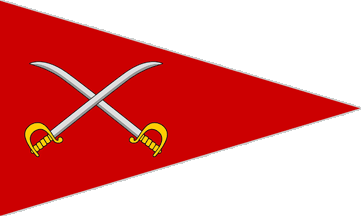
ASA Pennant
|
Army Sailing Association 1947
The Army Sailing Association (ASA) was formed in 1947 to manage sailing as a sport within the Army and to represent its interests at Service and national level. It caters to all sailing disciplines, including offshore and inshore yacht racing, dinghy and keel-boat racing, windsurfing and kitesurfing.
The ASA is managed by the Admiral and Flag Officers. All decisions must be approved by the ASA Council. The ASA board is appointed by the Army Board (through the Army Sport Control Board) as the authority, advisor and co-ordinator for the MoD (Army) of all sailing matters. With Club membership of the Royal Yachting Association (RYA), the ASA is a Recognised Training Centre and entitled to run RYA sail training and power-boating courses.
The ASA is also custodian of the ASA Blue Ensigns, burgees and racing flags. All full members who own yachts, of the appropriate size, are entitled to apply for the Blue Ensign and burgee. |
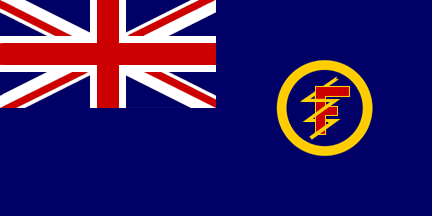
TS Foudroyant 1950
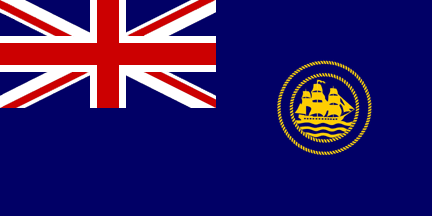
HMS Trincomalee 2005
|
The Blue Ensigns of HMS Trincomalee (TS Foudroyant) 1950-1986, 2005
HMS Trincomalee was built in Bombay as a 38 gun frigate in 1817, and is now the oldest ship afloat in the United Kingdom, probably the second oldest in the world. (The USS Constitution is the oldest.) The Trincomalee was to have been scraped in 1897, but was bought to replace the training ship Foudroyant, which had just been wrecked. After conversion she was re-named the Foudroyant in 1902 and served as a training ship until 1986. The hulls of obsolete wooden warships at permanent moorings in harbors and rivers around Britain were used as training ships. Between 1950 and 1986 she flew the Blue Ensign of TS Foudroyant. Restoration to her present condition was carried out by the Foudroyant Trust, which became the HMS Trincomalee Trust in 1992.
Once again named HMS Trincomalee, she is now preserved in Hartlepool (north-east England) as the central attraction in the maritime heritage area. She was granted her second special Blue Ensign in 2005. The badge, designed by Royal Navy Commander Bruce Nicolls, is based on the seal of the HMS Trincomalee Trust. It is not reversed on the other side of the ensign, and the ship "sails" towards the fly on the obverse side, and towards the hoist on the reverse side.
|
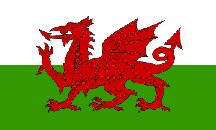
The Red Dragon Flag 1950
(Official)
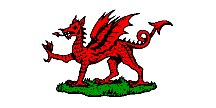
Red Dragon
without Tudor colors
(obscure variant)
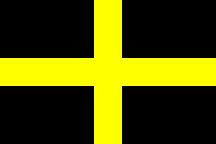
Saint David's Cross
(un-Official)
|
State Flag of Wales since 1950
The dragon symbol itself dates back to Roman times when it was the standard of the Roman cohort stationed in Wales (Part of the Tenth Legion). It was a prominent symbol across England and Wales in the years after the departure of the Romans, and during the era of the invasions of the Angles and Saxons.
The United Kingdom is Great Britain (England, Wales, Scotland) and Northern Ireland. Yet, although the "Y Ddraig Goch," or Red Dragon, is the national symbol of Wales, it doesn't appear on the Royal Standard, and there is no symbol for Wales on the Union Jack. This is because Wales was a principality of England before the Union of the Crowns in 1605, and not an independent kingdom. Even the title "Prince of Wales" that is traditionally given by the British Sovereign to the eldest son and heir to the throne, is just a title; Wales has never been ruled by the Prince of Wales. Today, the Red Dragon Flag has been officially recognized as the official State Flag of Wales, and in 1959, Queen Elizabeth II directed that the Red Dragon Flag could be flown over all Welsh government buildings in addition to the Union Flag, but not in a superior position.
An interesting historical note is that the red dragon symbol is centered over a white-over-green field. These were the livery colors of the Tudors, the only Welsh dynasty to rule England.
Not to be outdone by the other parts of the United Kingdom, the Welsh also use the Cross of Saint David for a national symbol. The flag's origins appear to be in the Anglican Church, and although it has become increasingly popular, it has never had any official status. In the Second World War, it was used as the division flag of the 38th Welsh Division, and Saint David's Cross is displayed in Scotland whenever Wales plays international rugby in Edinburgh. It has also been flown on a flag pole over the Capitol Building (the biggest shopping center in Cardiff City), and is increasingly being flown alongside the official Red Dragon flag in some parts of Wales. |
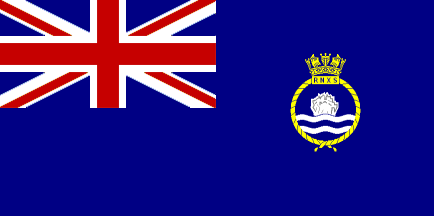
RNAS Blue Ensign
|
Royal Naval Auxiliary Service 1952-1994
In the United Kingdom any vessel flying an auxiliary service ensign has a civilian crew that is not subject to the Naval Discipline Act. A naval auxiliary is not commissioned and any armament carried is for defensive purposes only and must not be used offensively. The ensign of the Royal Naval Auxiliary Service is now obsolete, but it was originally established in 1952 as the "Royal Naval Minewatching Service." The Royal Naval Auxiliary Service was disbanded in 1994.
Their Flag was a blue ensign defaced with the Royal Naval Auxiliary Service badge on the fly. The badge is officially described as "Blue; over wavelets barry wavy of four white and blue a mine explosion proper." Basically it showed a mine exploding on the surface of a stylized body of water.
|
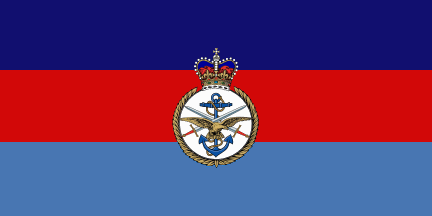
Chief of the Defense Staff
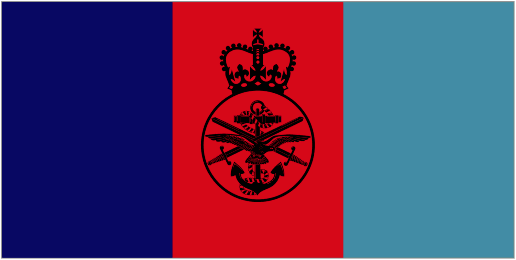
Joint Services Flag
|
Joint Services Flags since 1956
The Joint Services is basically a special command organization under the Minster of Defence representing all three United Kingdom Armed Services, including the Royal Navy, Army, and Royal Air Force. In 1956, a special flag for the Chiefs of Staff Committee was approved. Admiral of the Fleet, the Earl Mountbatten of Burma, became the first Chairman. Three years later his title, and that of the flag was changed to the Chief of the Defence Staff. A horizontal tricolor of dark blue, for the Royal Navy, over red for the Army, over light blue for the Royal Air Force, with the Joint Services badge centered, was chosen for the staff flag. The order of the stripes represented the seniority of the individual services. The white circular background of the badge was encircled by laurel leaves in gold.
In 1964, when the unified Ministry of Defence was formed, the shield from the 1956 Chief of the Defence Staff flag was adopted and placed on a vertical tricolor for the new Ministry flag (see below) and a similar new design introduced for the Joint Forces. The current Joint Services tricolored flag has a vertical "Navy" blue, "Army" red, and "Air Force" light blue striped design and sports a new more stylized badge.
Learn more about Joint Services Flags and Ministry of Defence Flags.
|
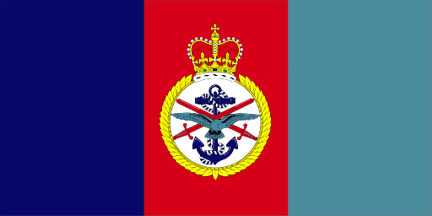
MOD Flag
|
Ministry of Defence Flag since 1964
The Ministry of Defence (MOD) is the United Kingdom's government department responsible for implementation of government defense policy and is the headquarters of the British Armed Forces.
The Ministry of Defence principal objectives are to defend the United Kingdom and its interests. Since the collapse of the Soviet Union and the end of the Cold War, the MOD has turned its attention to identifying weapons of mass destruction, stopping international terrorism and other threats to the UK's interests. The Ministry of Defence also manages the armed forces, does contingency planning and defense procurement.
The flag of Ministry of Defence, since 1964, when the Ministry of Defence was created by amalgamating the Board of Admiralty, the War Office and the Air Ministry, uses a badge based on the old 17th century Navy Board anchor symbol, which is still similar to that used by both the Navy Board and the Admiralty Board.
Learn more about Joint Services Flags and Ministry of Defence Flags. |
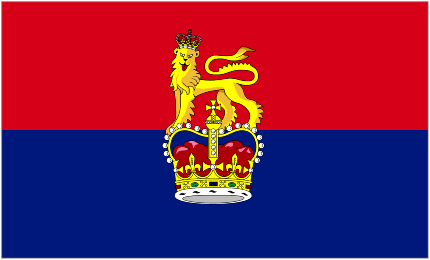
UK Army Board Flag
|
United Kingdom Army Board Flag since 1964
The Army Board consists of high ranking officers and civilian advisers headed by the Chief of the General Staff and the Executive Committee. The Executive Committee of the Army Board's mission is to assist the Chief of the General Staff in discharging his executive responsibilities for the delivery of coherent military capability, the current and future fighting effectiveness and efficiency of the Army, and the morale of the Service. It also helps oversee performance management, risk, budgetary, resource and financial assurance issues.
The Army Board did not exist before 1964, when the Board of Admiralty, Army Council and Air Council were combined into the Defence Council. The Army Board is the modern equivalent of the old Army Council, and this is the flag of a military member of the Army Board. They use this red over blue flag with the Royal Crest in the center when they meet and at their headquarters. |
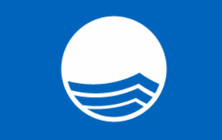
Blue Flag Award
(without date of award)
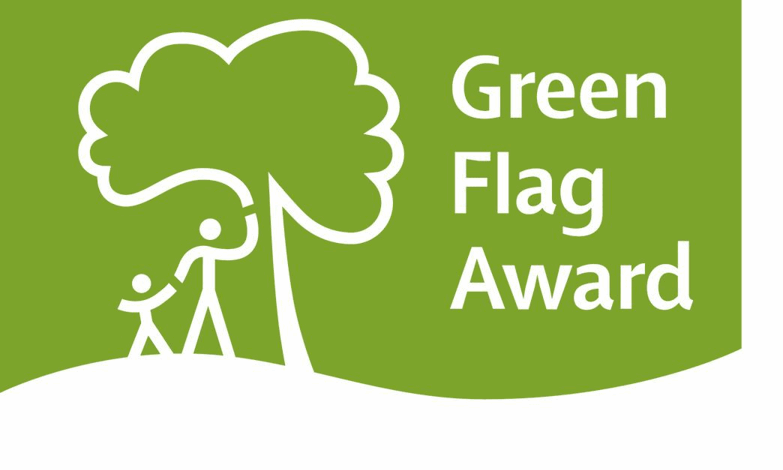
Green Flag Award
(without date of award)
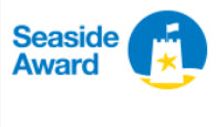
Seashore Flag Award
(without date of award)
|
Keep Britain Tidy Award Flags c1960-present
Keep Britain Tidy is a private British organization founded by Lady Elisbeth Brunner and the National Federation of Women's Institutes in 1954, whose goal was simply to "Keep Britain Tidy". They quickly got to work tackling litter and encouraging pride in their country. In 1959, they became an independent organization and using the iconic "Tidyman" logo that began appearing across England. World-famous entertainers such as Abba, Morecambe and Wise, The Bee Gees, Marc Bolan and David Cassidy, to name a few, have joined their efforts to clean up the environment.
Today, the KBT is one of the world’s largest environmental education programs reaching about five million United Kingdom students. Their Waste Watch program, for example, helps communities, local authorities, and land managers conserve resources across the whole United Kingdom, especially on environmental issues.
 Seashore Award Flag Variant (with date of award in gold)Each year these KBT flags are awarded to new parks and beaches that have maintained clean and safe standards for their facilities. The year that the flags are awarded has the date of the award added in either white (or gold) lettering.
Over 1,300 parks and beaches in England and Scotland and Northern Ireland are now proudly flying either their Green, Blue or Seashore Awards Flag, indicating how sucessful the program has become. A similar international organization, named the "Foundation for Environmental Education," started their own Blue Flag campaign in 1986, using the the KBT program as a model. |
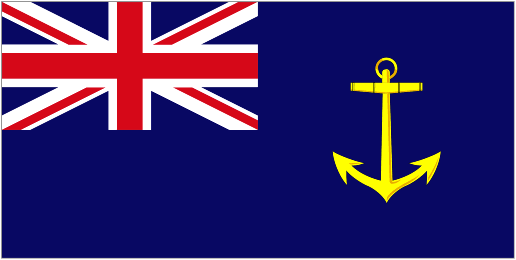
Royal Fleet Auxiliary Ensign
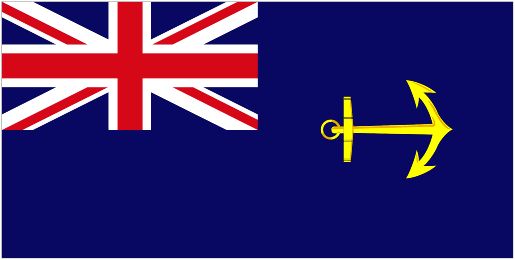
Government Service Ensign
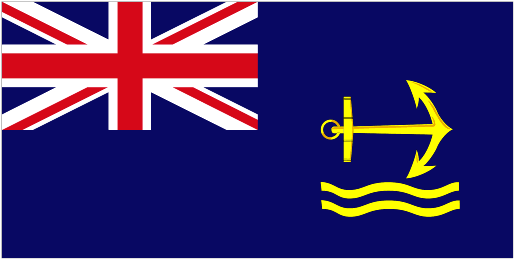
Royal Maritime Auxiliary Ensign
|
Royal Fleet Auxiliary Ensign 1969
The Blue ensign of the Royal Fleet Auxiliary features an upright anchor. Since the Royal Navy's logistical support is provided, not by commissioned naval vessels, but by the civilian-manned ships of the Royal Fleet Auxiliary Service (tankers, underway replenishment ships, and the like), they can not fly the White Ensign of the Royal Navy. For this reason they have been provided a special Blue Ensign with a gold anchor on the fly. The names of these ships are preceded by "RFA" instead of "HMS." The vertical anchor was introduced in 1969 as a separate ensign for the Royal Fleet Auxiliaries.
Government Service Ensign 1974
The ensign with the horizontal anchor was introduced in 1864 for all naval auxiliaries, including the Royal Fleet Auxiliary Service, and was known as the Admiralty Ensign until 1974 when it was renamed the Government Service Ensign. The Government Service Ensign has an anchor on the fly facing away from the hoist. It is commonly flown by vessels owned by the British Ministry of Defence, and is most commonly seen flown by warships undergoing trials before being commissioned into the Royal Navy, and former Royal Maritime Auxiliary Service vessels still not officially decommissioned.
Royal Maritime Auxiliary Ensign 1970-2008
There was also a version with two yellow wavy lines below the horizontal anchor, which was introduced in 1970 as the Royal Maritime Auxiliary Service, but became obsolete on 2008. There was also a Royal Naval Auxiliary Service with a different ensign.
Never under-estimate the ability of the British civil servants to keep things complicated. Recently reports of Blue Ensigns with the anchor badge completely up-side-down have surfaced, but as yet been un-identified. If this keeps up we might end up with a complete set of rotating anchor ensigns.
|
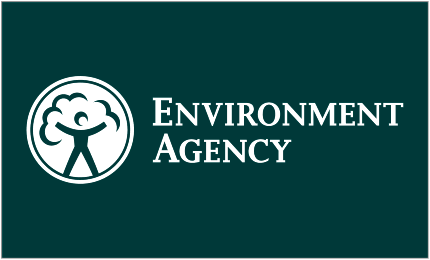
Environment Agency

Environment Agency (variant)
|
Environment Agency 1996
The Environmental Agency is an executive non-departmental public body responsible to the Secretary of State for Environment, Food and Rural Affairs and an Assembly Sponsored Public Body responsible to the National Assembly for Wales.
The Environment Agency was created by the Environment Act of 1995. It took over the roles and responsibilities of the National Rivers Authority (NRA), Her Majesty's Inspectorate of Pollution (HMIP) and the waste regulation authorities in England and Wales, including the London Waste Regulation Authority (LWRA). At the same time, the Agency took responsibility for issuing flood warnings to the public, a role previously held by the police.
Until the formation of the Environment Agency, the Government took specialist advice on the management of the environment from civil servants employed in appropriate ministries. This led to considerable duplication of effort and frequent disagreements between Government and the regulatory agencies. The Environment Agency now advises Government directly about those issues within its purview.
The Agency logo was designed by Coley Porter Bell in 2004. It uses an androgynous figure in an environment as an attempt to have a simple representation of people in the environment as opposed to the environment being thought of as uninhabited land. The color scheme was a combination of green and blue, which has been carried over into the flag designs. |
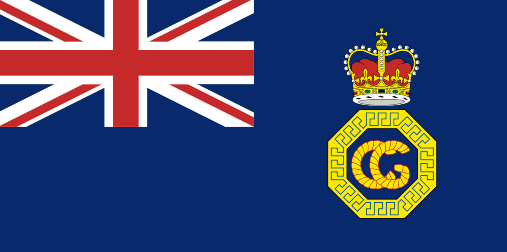
HMC Blue Ensign
|
Her Majesty's Coastguard since 1999
Her Majesty's Coastguard (HMC) is the government service concerned with coordinating all civilian maritime Search and Rescue, including the mobilization and organization of adequate resources to respond to persons either in distress at sea, or on the shoreline of the United Kingdom. It is part of a larger Maritime and Coastguard Agency. It was first formed in 1829, but the ensign illustrated dates from 1999.
The Flag of Her Majesty's Coastguard ensign is the standard blue ensign defaced with the HMC badge on the fly. This ensign design was introduced in 1974, but in the then standard size 4/9th of hoist badge. |
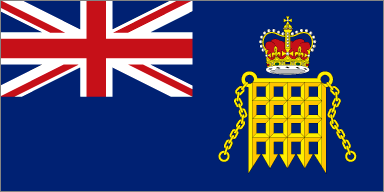
HMRC Ensign
|
Her Majesty's Revenue and Customs 1999-2008
Her Majesty's Revenue and Customs (HMRC) was formed in 2005, following the merger of Inland Revenue and Her Majesty's Customs and Excise. After 2008, it was then merged with the United Kingdom Border Agency (UKBA). The vessels which used to fly the HMRC ensign now fly the UKBA ensign (shown below). If this ensign is used at all now, it used only on land.
The last version of the Customs flag had a large badge (shown here), and the modern St. Edward's crown. Before 1999, the badge was smaller, and before 1952, the flag was charged with the imperial crown. |
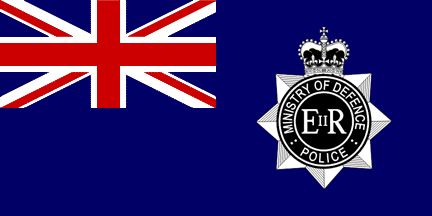
MDP Blue Ensign
|
Ministry of Defence Police 2004
The Ministry of Defence Police (MDP) is part of the United Kingdom's Ministry of Defence. It is part of the Ministry of Defence Police and Guarding Agency which was formed by merging the MDP and Ministry of Defence Guard Service (MGS) in 2004. The MDP is primarily responsible for providing police, investigative and guarding services to government property throughout the United Kingdom including high security sites, both military and civilian. The MDP has approximately 3,500 police officers based at 110 police units at 86 locations across the United Kingdom.
The flag of Ministry of Defence Police is the standard blue ensign defaced with the MDP shield on the fly. The ensign was granted in 1971, originally with the smaller size badge. |

Registered Vessel Ensign
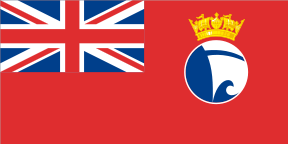
Fleet Vessels Ensign
|
National Historic Ships Red Ensigns 2006
The Advisory Committee on National Historic Ships was established in 2006 as a part of the Department for Culture, Media and Sport to advise the Secretary of State and other public bodies on ship preservation and funding priorities. They are charged with helping funding bodies who are attempting the preservation of historic ships, maintaining a watch list of vessels with potential historic significance, and providing direct assistance to vessel owners find funding grants, and keeping a directory of those with skills and services necessary to help in the preservation of historic vessels.
The National Register of Historic Vessels contains details of over 1,000 vessels. Within this group, there is a sub-group of vessels called the National Historic Fleet, these being the vessels entitled to fly the ensign with the coronet. These are distinguished, according to the National
Historic Ships Registry, by meriting a higher priority for their historic value and needing long term preservation. The National Historic Ships badge used on the fly represents the bow of a ship cutting through the waves. |
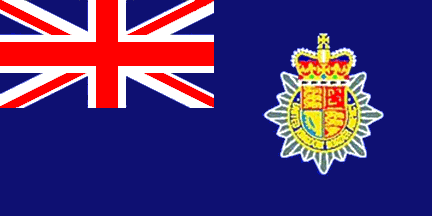
UKBA Ensign
|
United Kingdom Border Agency 2008
The United Kingdom Border Agency (UKBA) was formed in 2008. The agency protects the United Kingdom's borders, and is one of the largest law enforcement agencies in the UK. They number about 25,000, including more than 9,000 warranted Customs and Immigration Officers, who are stationed at all borders and across 135 countries worldwide. Customs officers have wide-ranging powers of entry, search and detention. Immigration officers have the power of arrest and detention conferred on them by the Immigration Act 1971, both at ports and inland.
The UKBA Ensign as flown from all their vessels, including all Customs Cutters, which serve a similar duty to those of United States Coast Guard Cutters. Their ensign is the standard blue ensign defaced with the UKBA shield on the fly. |

MVS Ensign
|
Maritime Volunteer Service Ensign 1998
The Maritime Volunteer Service is a nationwide uniformed civilian service based at around 35 locations on Britain´s coast. The service exists to keep alive British Maritime skills and train others in seamanship, navigation, marine engineering, radio operation and operational support. Their goal is "...to maintain a corps of trained volunteers capable of supporting maritime authorities ashore and afloat at maritime events or emergencies."
The Maritime Volunteer Service Ensign is a Red Ensign with the Volunteer Service badge placed on the fly. |
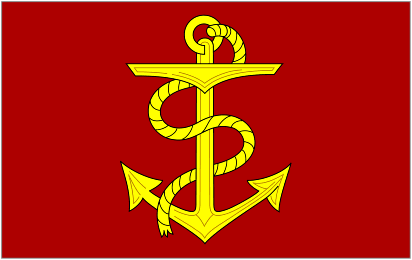
Admiralty Board Flag
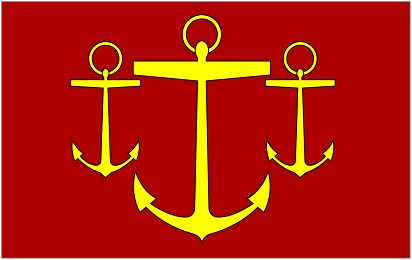
Naval Board Flag
|
United Kingdom Admiralty and Naval Board Flags
The Admiralty was formerly the authority in the United Kingdom responsible for the command of the Royal Navy. Originally it's leadership was the Lord High Admiral and his Lords Commissioners of the Admiralty, who sat on the Board of Admiralty. In 1964, the functions of the Admiralty were transferred to a committee of the tri-service Defense Council of the United Kingdom and became part of the Ministry of Defence.
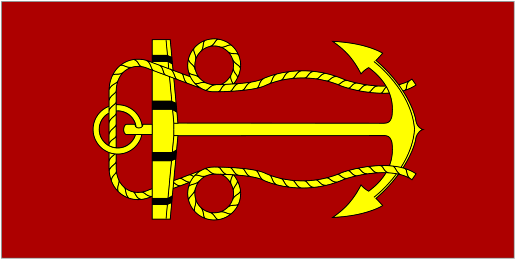 Lord High Admiral The Navy Board is today the body responsible for the day-to-day running of the British Royal Navy. Its composition is identical to that of the Admiralty Board of the Defence Council of the United Kingdom, except that it does not include any of Her Majesty's Ministers. |
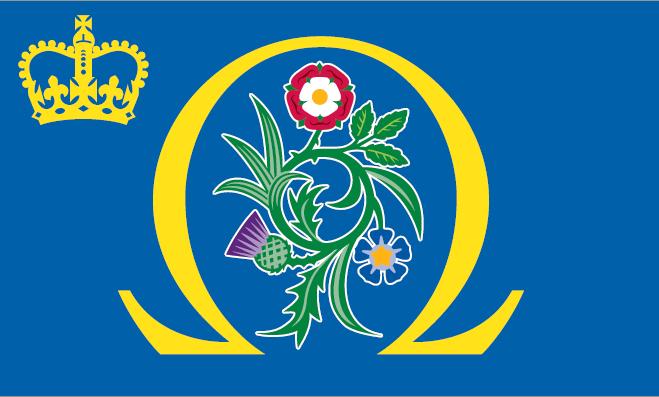
UKSC Flag
|
United Kingdom Supreme Court Flag 2009
The United Kingdom Supreme Court is the final court of appeal for all United Kingdom civil cases, and criminal cases from England, Wales and Northern Ireland. It is the final court of appeal, and plays an important role in the development of United Kingdom law. As an appeal court, the UK Supreme Court cannot consider a case unless it has been first tried in a lower court.
The flag incorporates the elements of the Supreme Court's emblem: floral designs of the four constituent parts of the UK, and an omega symbol implying finality, with the crown of the Sovereign - the font of justice in Britain - offset in the corner. An unusual practice surrounding the new flag is that it is to fly on a single pole, below the Union Jack, which is is very rarely seen in formal British practice. |
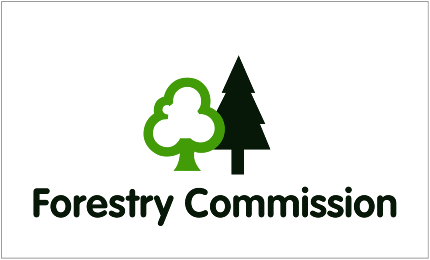
Forestry Commission
|
Forestry Commission
The Forestry Commission of Great Britian origins are in the First World War, and the difficulties Britain had meeting wartime demands on timber. Woodland resources had been declining since the middle ages, but reached an all time low in the wake of the Industrial Revolution. With the outbreak of war the country was no longer able to rely on timber imports, and in 1916 the Acland Committee was organized to look at the best ways of developing woodland resources. The committee recommended a state organization be formed to coordinate government and private forestry efforts.
In 1919 the Forestry Act set up the Forestry Commission and gave it responsibility for woods in England, Scotland, Wales and Ireland. Today, the Forestry Commission still oversees the efforts and works closely with conservation and environmental groups. |
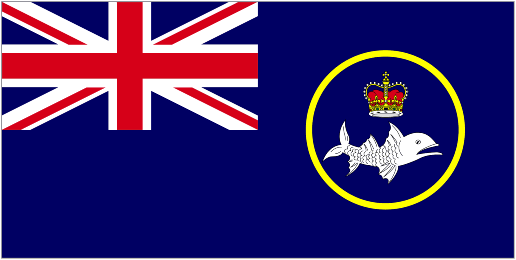
DEFRA Flag
|
Department for the Environment, Food and Rural Affairs 1913
The Department for Environment, Food and Rural Affairs (DEFRA) is the United Kingdom department responsible for policy and regulations on environmental protection, food production and standards, agriculture, fisheries and rural communities in the United Kingdom. Although DEFRA only works directly in England, they also work closely with similar administrations in Wales, Scotland and Northern Ireland, and they generally lead on environmental negotiations in the EU and internationally.
The flag is a blue ensign, with a badge consisting of a fish and crown in a yellow circle. The original flag, with a small sized badge, dates from about 1913 when it was called the Board of Agriculture and Fisheries. |
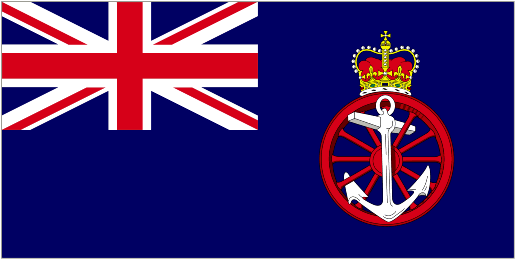
DfT Flag
|
Department for Transport Flag 1950
Originally known as the Ministry of Transport (MoT) the Department for Transport (DfT) is the government department responsible for the English transport network and a limited number of transport matters in Scotland, Wales and Northern Ireland. The department is run by the Secretary of State for Transport.
The flag is a blue ensign with a red wheel and white anchor badge. This flag was also used at Coast Guard Stations on land prior to 1974 before the Coast Guard received its own flag. The orginial Transportation Department flag dates from 1950 when it replaced the original, winged wheel flag of 1920. |
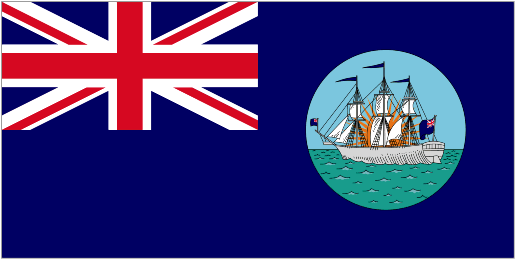
DTI (BIS) Flag
|
Department of Trade and Industry Flag
The Department of Trade and Industry, formally the Board of Trade,
was a United Kingdom government department with a wide range of responsibilities, including: Company Law, Trade, Business Growth, Innovation, Employment Law, Regional Economic Development, Energy, Science, and Consumer Law. In 2005, the DTI was split into three parts: the Department for Business, Innovation and Skills (BIS), the Department for Business, Enterprise and Regulatory Reform (BERR), and the Department for Innovation, Universities and Skills (DIUS). There is, however, still a Board of Trade, although now just a part of the Department for Business, Enterprise and Regulatory Reform.
The flag was a Blue Ensign with the badge of the Board of Trade on its fly. The badge was original introduced in about 1850 on a Red Ensign, for the Board of Trade. It displayed a sailing ship flying an ensign. |
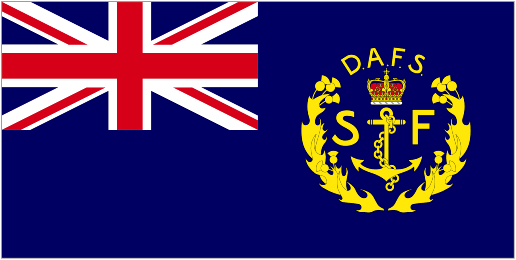
Scottish Fisheries Board Flag
|
Scottish Executive Department for Rural Affairs Flag
The Scottish Executive of Rural Affairs Department is now responsible for most of the issues concerning the health, education, justice, rural affairs, and transport of the Scottish people. The Scottish Government was known as the "Scottish Executive" when it was established in 1999 following the first elections of the Scottish Parliament.
The modern ensign features a Scottish crown and the initials for the old Department of Agriculture and Fisheries, Scotland (DAFS). The new name is Department for Rural Affairs. The ensign is now used by two agencies of the Scottish Executive Rural Affairs Department, the Scottish Fisheries Protection Agency and the Fisheries Research Service. |
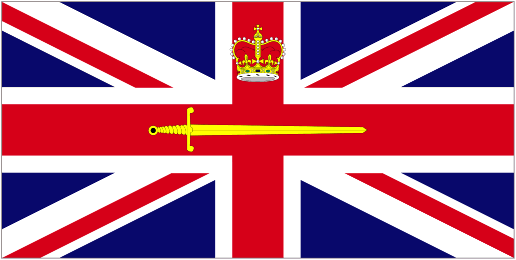
Lord Lieutenant Ensign
|
County Lord Lieutenant Ensign
The title Lord-Lieutenant is given to the British monarch's personal representatives around the United Kingdom. Usually some retired local notable, a senior army officer, peer or business person is given this honorary post.
The title Lord-Lieutenant is basically given to individuals whose job is to act as the monarch's representatives and to "promote a spirit of co-operation and good atmosphere by the time they give to voluntary and benevolent organisations and by the interest they take in the business and social life of their counties."
In short, Lord-Lieutenants act as county public relation officers for the crown. |

High Sheriff
|
High Sheriffs Pennant for England and Wales
The Office of High Sheriff is an independent non-political Royal appointment for a single year. The origins of the Office date back to Saxon times, when the "Shire Reeve" was responsible for the maintenance of law and order within the shire, or county, and for the collection and return of taxes due to the Crown. Today, there are 55 High Sheriffs serving the counties of England and Wales each year.
The High Sheriffs actively lend support and encouragement to crime prevention agencies, the emergency services and to the voluntary sector. In recent years High Sheriffs in many parts of England and Wales have been particularly active in encouraging crime reduction initiatives, especially amongst young people. High Sheriffs also assist Community Foundations and local charities. The High Sheriff Association adopted DebtCred and Crimebeat in recent years in response to specific areas of need. |
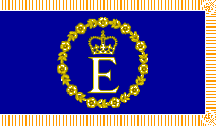
Queen Elizabeth's Flag
|
Queen Elizabeth's Personal Flag
Queen Elizabeth's Personal Flag which she flies when visiting Commonwealth countries of which she is not Head of State.
For example, notice how the "E" motif is incorporated into the Arms of Australia and Canada to produce the respective Royal Banners (see below). |
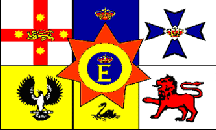
Australian Royal Standard
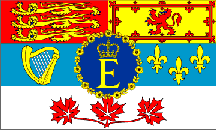
Canadian Royal Standard
|
Commonwealth Royal Standards
British Commonwealth of Nations Flag
Two examples of Royal Standards of current British Commonwealth nations are shown to the left. These flags are flown for Queen Elizabeth when she visits these British Commonwealth nations, of which she is still considered the Head of State.
The Commonwealth of Nations is actually a voluntary association of 53 independent sovereign states, most of which are former British colonies. Although no single government in the Commonwealth exercises power over the others, some still consider the British King or Queen of England their traditional Head of State.
|
|
|
Commonwealth of Nations Flag 1976 |
|
Commonwealth of Nations Flag 2013 |
In 2013, the Commonwealth of Nations flag was simplified and modernized at the request of the Commonwealth Secretariat. The number of "spearheads" was reduced from 64 to 34, the globe was slightly altered to make it standout better, the blue field color was lightened a bit, and the emblem was slightly tilted towards the hoist. According to the Secretariat "The radiating spears do not represent the number of countries in the Commonwealth, but symbolizes the many facets of Commonwealth cooperation around the world."
|

Disunion Jack
(speculation?)
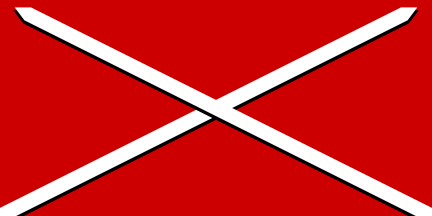
SJP Party Flag
|
Disunion Jack 2012
Scottish Jacobite Party c2005
This amusing flag design was used by the Scottish Jacobite Party, a minor political party which advocates Scottish independence. The flag was used on at least one occasion, together with traditional flags of Scotland and the SJP Party. The flag gained more notoriety in 2012 when Scottish First Minister Alex Salmond and Deputy PM Nick Clegg clashed publicly over the Scottish independence issue. The flag is, of course, the British Union Flag stripped of its distinctive Scottish blue background. It should be pointed out that this flag design is very unlikely because even if Scotland did become independent and a republic, like in many parts of the former British Empire, Great Britain's royal family would probably still be considered the "monarchs" of Scotland, as they have since 1606, and the Union flag would therefore most likely remain unchanged.
The Scottish Jacobite Party was founded in 2005. Unlike the original
Jacobites, whose goal was to restore the House of Stuart to the thrones of the Scotland, England, and Ireland, this modern party wants to make Scotland an independent republic, which would leave the European Union and also annex the some parts of northern England. It should be noted the SJP Party has not won a significant number of votes in any national election, but has caused a great deal of public comment on the issue, both pro and con.
The use of red and white as colors on the SJP Flag can be attributed to the original Jacobites, but the use of sword blades instead of the saltire appears unique, and is probably used as a symbol of struggle. |
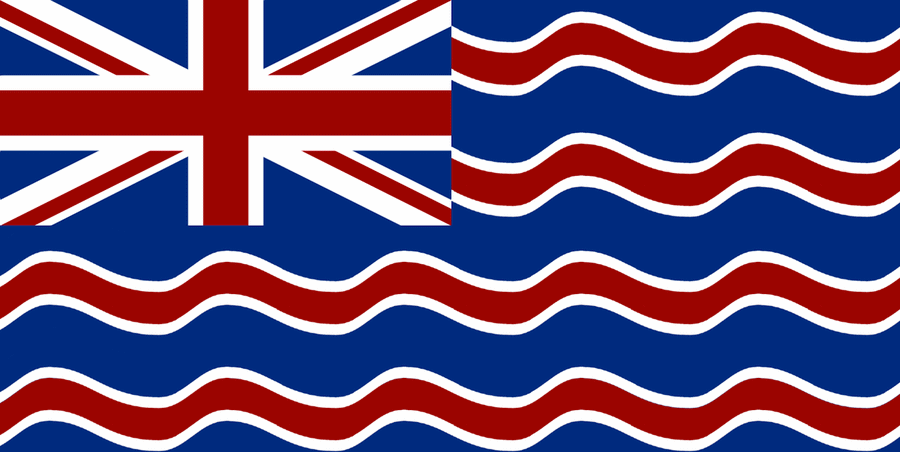
Proposed OFBOT Flag
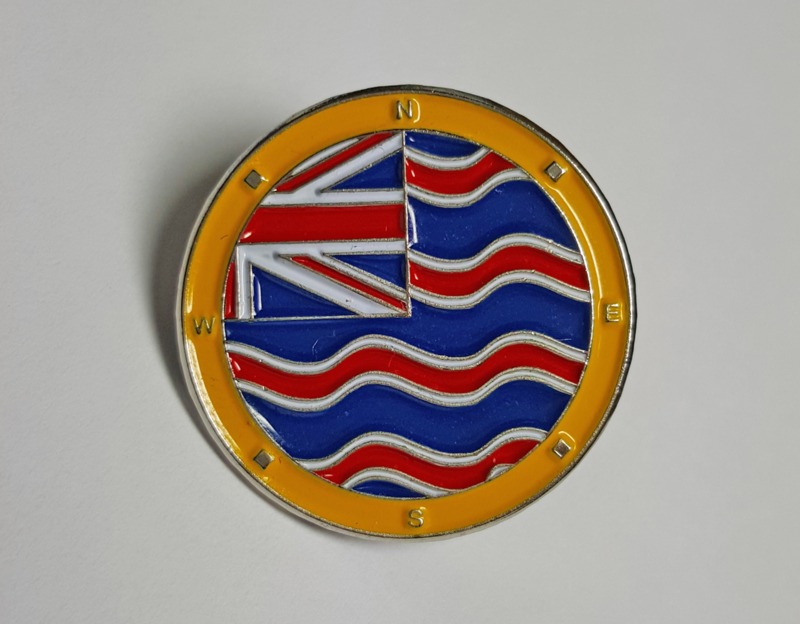
OFBOT Badge
|
Organization of the Friends of the British Overseas Territories
The Organization of the Friends of the British Overseas Territories (OFBOT) is a charitable organization which promotes and supports an increased awareness of the British Overseas Territories both in the United Kingdom and across the world.
Their goal is to educate the public to the geography, conservation, protection and improvement of these British Overseas Territories. This includes sponsoring special educational visits of British youth to the British Overseas Territories.
The only physical existence of their flag is currently on their badges, which are worn by their members at their events and casually by members across the world. It is not an official flag for British overseas territories, but the winning result of a contest held to design a flag for the Friends of the British Overseas Territories organization.
Pictured here is the current drawing of what their flag will look like when manufactured, however, as previously stated, it still only exists on the pictured badge right now. |
- My thanks to David Prothero and Michael Faul for their invaluable help on this page -
| Page #1 (1189-1800) | Page #2 (1800-1900) | Page #3 (1900-present) | English County Flags |
|